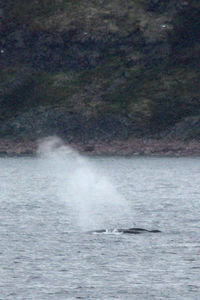Advertisement

 Humpback
Humpback
Thar' she blows!Harold's new Canon Rebel got quite a work out on the trip. The result is many wonderful closeups impossible without a good zoom lens.
Point Amour is known as a great whale watching spot and we saw several in the rain on June 25.
To our utter delight and great good luck, by the next day, the capelin had arrived and the whales were in a feeding frenzy thanks to these little morsels that they eat by the millions.
You could actually see a dark circle in water indicating the presence of capelin, you got an oily fish smell and the birds, seals and whales all gravitated to the same location for their gourmet dinner.
We saw quite a few whales while at Red Bay and then later in the afternoon we returned to Point Amor and it seemed there were whales wherever we looked! Truly a highlight within an outstanding trip!! Our guide from Wildland Tours, Mark, shared our excitement. I thought, wow, if the guide who can see this often gets excited, it reveals his own passion for this part

 Humpback
Humpback
Near Saddle Island in Red Bayof the world, plus he was so adept at pointing out where to look in the vast blue water for whales.
Capelin (traditional Newfoundland spelling 'caplin') are the most important forage species in the Northwest Atlantic providing a vital link in the food chain between plankton and larger animals. They are a small silvery fish and a close relative of the freshwater smelt.
They spend the bulk of their lives offshore moving inshore only to spawn which takes place on beaches in June and July and attracts predators including fish, seabirds, whales, eagles and ospreys.
Newfoundlanders call this the "capelin scull" and evenings in June and July will find adults and children down on the beaches equipped with buckets and dip nets to gather up this ocean bounty.
Traditionally capelin were spread on gardens as fertilizer. Dried salted capelin are a traditional Newfoundland snack roasted on a stick over a camp fire.
Today, there is a commercial fishery for capelin that provides females with roe to the Japanese market. Many Newfoundlanders believe that this is a very dangerous and wasteful fishery that should be discontinued.
It results in the largest roe-bearing females selected and
then frozen for export to Japan. The rest, tens of thousands of tones of small female and male capelin are dumped out of fish processing plants into the sea. Japan once had capelin, but overfishing has pretty much destroyed the stock.
Advertisement
Tot: 0.122s; Tpl: 0.011s; cc: 10; qc: 50; dbt: 0.067s; 1; m:domysql w:travelblog (10.17.0.13); sld: 1;
; mem: 1.1mb

 Humpback
Humpback
 Humpback
Humpback